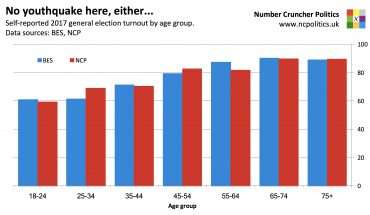There is a more up-to-date analysis of the Lib Dem polling and prospects here.
The collapse of the Lib Dems in the polls has raised the question of how well their MPs can be in the face of the national swing against them, with much guesswork and speculation. I decided to do the maths and estimate, for given degrees of swing and incumbency bonus, how many seats would be “saved” relative to a UNS. In each case I’ve also shown how many seats would be lost purely on a UNS basis.
Some things to note:
- In each case, I’m using the standard ‘Butler’ swing (vs the 2010 result) from the Lib Dems to the nearest challenger, whereas the incumbency bonus is measured in absolute, Lib Dem vote share terms. Therefore 2 points of incumbency bonus equate to 1 point less swing.
- The results are based on a UNS (apart from the incumbency effect, obviously) whereas in reality swings in contests involving Lib Dems can be are highly variable.
- The incumbency bonus is assumed to be equal for all Lib Dem incumbents
- As I’m only looking at incumbent MPs, I’ve assumed zero deviation from UNS in the 9 seats where the incumbent is stepping down.
You can see that for smaller swings, fewer seats are ‘saved’ because fewer seat losses would be implied by a uniform swing. The ‘seats saved’ value of the incumbency boost is typically highest for the mid-single digits of swing. But given the differences in swings, allied to the widespread perception (supported, for example, by Ashcroft polling) that LIB-LAB and LIB-CON battlegrounds will behave differently, it’s more helpful to examine these in isolation.
Here are the seats that the Lib Dems are defending from Conservatives. I’ve based this on who came second in 2010, rather than any kind of view on who is likely to be the nearest challenger in 2015:
We can see that, for example, a 4% scenario doesn’t save many more than 7 seats, creeping into double-digits if we assume 6%. Now for the seats the Lib Dems are defending from Labour, on the same basis as the above:
It’s worth reminding readers that a given incumbency effect will appear smaller in terms of seats in the LIB-LAB battleground because it is smaller (about half the size in terms of total seats held) of the LIB-CON battleground. This is why, as can be seen, even the larger incumbency effect scenarios only save around five seats from Labour (and smaller assumptions considerably fewer).
In addition to the contests with Labour and the Conservatives, the Lib Dems are also defending Ceredigion from Plaid Cymru (21.8% majority) and Gordon from the SNP (where their incumbent is standing down, from a 13.8% majority).
So to conclude, bearing in mind all the caveats noted above, this analysis suggests that an incumbency effect of around 6 points would likely be needed to save more than ten seats relative to a uniform national swing. On current polling, this points to a seat total somewhere in the 20s. But I’ll avoid making formal seat projections for the time being.
In future posts I’ll also examine the size of the incumbency bonus and the differential swings themselves.




